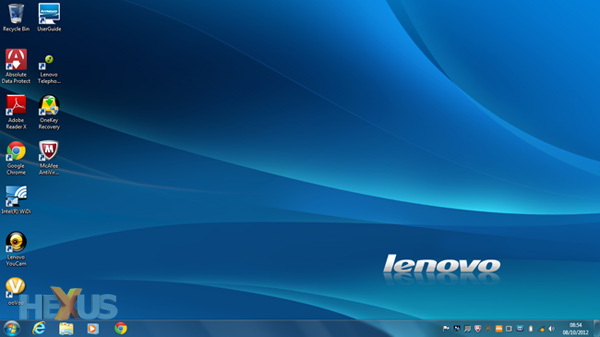Software and Performance
Ultrabook or not, it's rare to find a laptop without a bit of bloatware. No surprise, then, to find that Lenovo's U310 ships with a couple of pre-installed software utilities that you may or may not want.
These include McAfee AntiVirus Plus (which has a tendency to nag more often then we'd like), Google's Chrome web browser (as well as a few toolbars), a trial of Microsoft Office 2010, a video-chat app dubbed ooVoo and a few Lenovo utilities - YouCam, Face Recognition, Smart Update and OneKey Recognition.
Lenovo U310 specification |
|
|---|---|
| Processor | Intel Core i5-3317U (1.70GHz, 3MB cache, dual-core, 17W) |
| Memory | 4GB DDR3 |
| Graphics | Intel HD 4000 |
| Display | 13.3in - 1,366x768 |
| Battery | Lithium Polymer, 46 Whr |
| Weight | 1,699g |
| Wireless | Qualcomm Atheros AR9285 (802.11bgn) |
| Primary Storage | Samsung MZMPC032HBCD 32GB SSD cache |
| Seconday Storage | Hitachi HTS54505A7E380 500GB, 5,400RPM HDD |
| Operating System | Microsoft Windows 7 Home Premium, 64-bit |
There aren't really any major offenders here (though McAfee is borderline) and the pre-installed apps don't appear to restrict performance. Our review sample is the £650 variant and includes a low-voltage Intel Core i5-3317U 'Ivy Bridge' processor, 4GB of DDR3 memory, integrated Intel HD 4000 graphics and a hybrid storage solution that consists of a 32GB Samsung SSD cache, along with a 500GB Hitachi hard disk.
Attaching a smaller solid-state cache to a traditional hard disk allows Lenovo to offer a good amount of capacity while retaining the speed attributes of SSD storage, and Intel's Smart Response Technology (SRT) manages the cache without any user intervention. In a nutshell, it effectively monitors system usage and moves frequently-accessed files to the SSD for rapid reading of data, while all writes are automatically directed to the quicker SSD before being mirrored to the slower hard disk.
The performance of a hybrid cache doesn't come with the same guarantee as a standalone SSD - there's an obvious reliance on the cache algorithms - but Lenovo's hybrid solution appears to be working; our U310 boots to the Windows desktop in roughly 22 seconds, it resumes from sleep in just three seconds and it feels ultra-responsive during regular use.
Let's find out if the sense of speed is backed up by widely-used benchmarks. For reference's sake, we've included comparison results from a 13.3in Samsung Series 9 Ultrabook armed with a second-generation Core i5-2467M processor, as well as a 15.6in HP Pavilion dv6 powered by an AMD A6-3430MX APU.

Cinebench examines the multi-core capabilities of each system's CPU, and it's no surprise to find that the third-generation Core i5-3317U powering the Lenovo U310 leads the pack.

PCMark 7 provides a good analysis of overall system performance, and it proves a point; pairing a third-generation Core i5 processor with a hybrid storage solution makes for a potent mix.

But there are limitations. Lenovo's U310 feels particularly nippy during everyday tasks, and it certainly won't mind multi-tasking, but the underlying Intel HD 4000 graphics processor will only do so much. While perfectly adept at playing back high-definition media, the GPU doesn't have a great amount of oomph - it doesn't score particularly well in 3DMark 11, and while trying to play Just Cause 2 with medium quality settings, we returned an average of just 8.3 frames per second. Then again, this is a step up from previous-generation Ultrabooks - the older Samsung Series 9 comparison features Intel HD 3000 graphics, which won't even run 3DMark 11.










